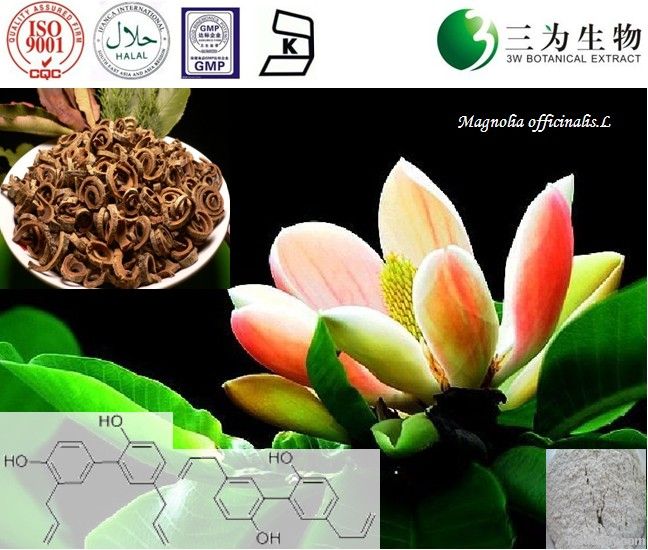

FOB Price
Get Latest Price|
- Minimum Order
Country:
China
Model No:
10~95% Magnolol and Honokiol
FOB Price:
Place of Origin:
-
Price for Minimum Order:
-
Minimum Order Quantity:
-
Packaging Detail:
-
Delivery Time:
-
Supplying Ability:
-
Payment Type:
-
Product Group :
-
Contact Person Jim
F25, Jiahe BLDG., No.217 Wanjiali RD., Furong Dist., Changsha Hunan, Changsha, Hunan
Magnolia extract, *0-*5% Magnolia Total Phenolic
CAS#: *******8/ *********6
Main Contents: Magnolol, Honokiol
Plant Resource: Magnolia officinalis.L
Product Specification: Magnolol and Honokiol HPLC*0%, *0%, *5%
Appearance: Light brown to pure white powder
Plant Part Used: The dried bark of roots or stems
Extract Solution: Grain alcohol
Molecular formula and weight: C*8H*8O2,**6.**4
Melting Point: ******3/*7.***7.6 centigrade
Measurement system: HPLC adopted with ultrasonic assisting, dissolving by chromatogram class methanol.
What is Magnolia Extract?
Native to China, the bark of Magnolia is being researched as an agent against amoebic dysentery. In ancient times, this herb was favored for increasing longevity, brightening the eyes and making the body feel light. The parts of this herb used medicinally include the bark, and the unopened flower buds. The unopened flowers, not bark, are a decongestant and can be used for nasal congestion, rhinitis, sinus headaches, and sinusitis. The flower buds open nasal obstructions by helping the body expel mucus. The bark has been used to break addiction to cigarettes. The primary properties of Magnolia Bark are analgesic, antifungal, anti-inflammatory, antiseptic, antispasmodic, astringent, carminative, hypotensive, and stimulant. The Japanese use Magnolia to help control stress and anxiety. Japanese researchers have determined that "honokiol" and "magnolol", two chemicals found in Magnolia Bark, are up to ***0 times more potent than Vitamin E in antioxidant activity. The bark also contains isomagnolol, essential oils (eudesmol, maschilol, pinene), alkaloids (magnoflorine, salicifoline, magnocurarine), and tannin. The unopened flower buds contain essential oils (anethole, camphene, cineol, estragole, eugenol, limonene, pinene, safrole), alkaloids, and beta carotene. Magnolia has several known topical usages including its use as a douche (made from the bark) for leukorrhea. In Central America, Magnolia schiedeana is used topically as a poultice for scorpion stings. In general, bark is harvested from Magnolia officinalis, while the unopened flower buds are from Magnolia liliflora. The common name Magnolia also includes the species Magnolia glauca and Magnolia grandiflora.
Where will Magnolia Extract be used for?
*- Eliminate damp
*- Relieve distension
*- Tonifying blood
*- Relieving pain
*- Nourishing the liver
Packing Detail: Packed in *0cm**0cm paper-drums and two plastic-bags inside.
Net Weight:*5kgs/drum.
Storage Situation: Stored in a well-closed container away from moisture and light.
Shelf Life:Two years under well Storage situation and stored away from direct sun light.
Why do we suggest you to select 3W’s Magnolia Bark Extract:
A.) 3W’s Magnolia Extract is **0% extracted from natural plant, very safe and more bioactive.
B.) 3W has the most purity Magnolia Extract, our Magnolia Extract is tested by HPLC.
| Country: | China |
| Model No: | 10~95% Magnolol and Honokiol |
| FOB Price: | Get Latest Price |
| Place of Origin: | - |
| Price for Minimum Order: | - |
| Minimum Order Quantity: | - |
| Packaging Detail: | - |
| Delivery Time: | - |
| Supplying Ability: | - |
| Payment Type: | - |
| Product Group : | - |